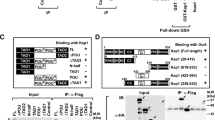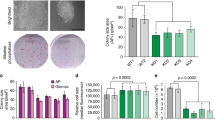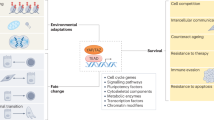Abstract
Understanding and controlling the mechanism by which stem cells balance self-renewal versus differentiation is of great importance for stem cell therapeutics. Klf4 promotes the self-renewal of embryonic stem cells, but the precise mechanism regulating this role of Klf4 is unclear. We found that ERK1 or ERK2 binds the activation domain of Klf4 and directly phosphorylates Klf4 at Ser123. This phosphorylation suppresses Klf4 activity, inducing embryonic stem cell differentiation. Conversely, inhibition of Klf4 phosphorylation enhances Klf4 activity and suppresses embryonic stem cell differentiation. Notably, phosphorylation of Klf4 by ERKs causes recruitment and binding of the F-box proteins βTrCP1 or βTrCP2 (components of an ubiquitin E3 ligase) to the Klf4 N-terminal domain, which results in Klf4 ubiquitination and degradation. Overall, our data provide a molecular basis for the role of ERK1 and ERK2 in regulating Klf4-mediated mouse embryonic stem cell self-renewal.
This is a preview of subscription content, access via your institution
Access options
Subscribe to this journal
Receive 12 print issues and online access
$189.00 per year
only $15.75 per issue
Buy this article
- Purchase on Springer Link
- Instant access to full article PDF
Prices may be subject to local taxes which are calculated during checkout






Similar content being viewed by others
References
Moretti, A. et al. Mouse and human induced pluripotent stem cells as a source for multipotent Isl1+ cardiovascular progenitors. FASEB J. 24, 700–711 (2010).
Nakagawa, M. et al. Generation of induced pluripotent stem cells without Myc from mouse and human fibroblasts. Nat. Biotechnol. 26, 101–106 (2008).
Okita, K., Ichisaka, T. & Yamanaka, S. Generation of germline-competent induced pluripotent stem cells. Nature 448, 313–317 (2007).
Van Hoof, D. et al. Phosphorylation dynamics during early differentiation of human embryonic stem cells. Cell Stem Cell 5, 214–226 (2009).
Tsuruzoe, S. et al. Inhibition of DNA binding of Sox2 by the SUMO conjugation. Biochem. Biophys. Res. Commun. 351, 920–926 (2006).
Baltus, G.A. et al. Acetylation of sox2 induces its nuclear export in embryonic stem cells. Stem Cells 27, 2175–2184 (2009).
Saxe, J.P., Tomilin, A., Scholer, H.R., Plath, K. & Huang, J. Post-translational regulation of Oct4 transcriptional activity. PLoS ONE 4, e4467 (2009).
Wei, F., Scholer, H.R. & Atchison, M.L. Sumoylation of Oct4 enhances its stability, DNA binding, and transactivation. J. Biol. Chem. 282, 21551–21560 (2007).
Garrett-Sinha, L.A., Eberspaecher, H., Seldin, M.F. & de Crombrugghe, B. A gene for a novel zinc-finger protein expressed in differentiated epithelial cells and transiently in certain mesenchymal cells. J. Biol. Chem. 271, 31384–31390 (1996).
Bruce, S.J. et al. Dynamic transcription programs during ES cell differentiation towards mesoderm in serum versus serum-free BMP4 culture. BMC Genomics 8, 365 (2007).
Evans, P.M. & Liu, C. Roles of Krüpel-like factor 4 in normal homeostasis, cancer and stem cells. Acta Biochim. Biophys. Sin. (Shanghai) 40, 554–564 (2008).
Takahashi, K. & Yamanaka, S. Induction of pluripotent stem cells from mouse embryonic and adult fibroblast cultures by defined factors. Cell 126, 663–676 (2006).
Roth, G. et al. MAP kinases Erk1/2 phosphorylate sterol regulatory element-binding protein (SREBP)-1a at serine 117 in vitro. J. Biol. Chem. 275, 33302–33307 (2000).
Sharrocks, A.D., Yang, S.H. & Galanis, A. Docking domains and substrate-specificity determination for MAP kinases. Trends Biochem. Sci. 25, 448–453 (2000).
Tanoue, T., Maeda, R., Adachi, M. & Nishida, E. Identification of a docking groove on ERK and p38 MAP kinases that regulates the specificity of docking interactions. EMBO J. 20, 466–479 (2001).
Rice, P., Longden, I. & Bleasby, A. EMBOSS: the European Molecular Biology Open Software Suite. Trends Genet. 16, 276–277 (2000).
Ying, Q.L. et al. The ground state of embryonic stem cell self-renewal. Nature 453, 519–523 (2008).
Nakatake, Y. et al. Klf4 cooperates with Oct3/4 and Sox2 to activate the Lefty1 core promoter in embryonic stem cells. Mol. Cell. Biol. 26, 7772–7782 (2006).
Rodolfa, K.T. & Eggan, K. A transcriptional logic for nuclear reprogramming. Cell 126, 652–655 (2006).
Cardozo, T. & Pagano, M. The SCF ubiquitin ligase: insights into a molecular machine. Nat. Rev. Mol. Cell Biol. 5, 739–751 (2004).
Liu, N. et al. The Fbw7/human CDC4 tumor suppressor targets proproliferative factor KLF5 for ubiquitination and degradation through multiple phosphodegron motifs. J. Biol. Chem. 285, 18858–18867 (2010).
Williams, R.L. et al. Myeloid leukaemia inhibitory factor maintains the developmental potential of embryonic stem cells. Nature 336, 684–687 (1988).
Smith, A.G. et al. Inhibition of pluripotential embryonic stem cell differentiation by purified polypeptides. Nature 336, 688–690 (1988).
Niwa, H., Burdon, T., Chambers, I. & Smith, A. Self-renewal of pluripotent embryonic stem cells is mediated via activation of STAT3. Genes Dev. 12, 2048–2060 (1998).
Rodda, D.J. et al. Transcriptional regulation of nanog by OCT4 and SOX2. J. Biol. Chem. 280, 24731–24737 (2005).
Hall, J. et al. Oct4 and LIF/Stat3 additively induce Krüppel factors to sustain embryonic stem cell self-renewal. Cell Stem Cell 5, 597–609 (2009).
Burdon, T., Stracey, C., Chambers, I., Nichols, J. & Smith, A. Suppression of SHP-2 and ERK signalling promotes self-renewal of mouse embryonic stem cells. Dev. Biol. 210, 30–43 (1999).
Rowland, B.D. & Peeper, D.S. KLF4, p21 and context-dependent opposing forces in cancer. Nat. Rev. Cancer 6, 11–23 (2006).
Zhang, P., Andrianakos, R., Yang, Y., Liu, C. & Lu, W. Krüppel-like factor 4 (Klf4) prevents embryonic stem (ES) cell differentiation by regulating Nanog gene expression. J. Biol. Chem. 285, 9180–9189 (2010).
Chuderland, D. & Seger, R. Protein-protein interactions in the regulation of the extracellular signal-regulated kinase. Mol. Biotechnol. 29, 57–74 (2005).
Yoon, S. & Seger, R. The extracellular signal-regulated kinase: multiple substrates regulate diverse cellular functions. Growth Factors 24, 21–44 (2006).
Fernandes, N., Bailey, D.E., Vanvranken, D.L. & Allbritton, N.L. Use of docking peptides to design modular substrates with high efficiency for mitogen-activated protein kinase extracellular signal-regulated kinase. ACS Chem. Biol. 2, 665–673 (2007).
Sheridan, D.L., Kong, Y., Parker, S.A., Dalby, K.N. & Turk, B.E. Substrate discrimination among mitogen-activated protein kinases through distinct docking sequence motifs. J. Biol. Chem. 283, 19511–19520 (2008).
Li, H.X. et al. Krüppel-like factor 4 promotes differentiation by transforming growth factor-beta receptor-mediated Smad and p38 MAPK signaling in vascular smooth muscle cells. J. Biol. Chem. 285, 17846–17856 (2010).
Tan, F. et al. Proteomic analysis of ubiquitinated proteins in normal hepatocyte cell line Chang liver cells. Proteomics 8, 2885–2896 (2008).
Boyer, L.A. et al. Polycomb complexes repress developmental regulators in murine embryonic stem cells. Nature 441, 349–353 (2006).
Hailesellasse Sene, K. et al. Gene function in early mouse embryonic stem cell differentiation. BMC Genomics 8, 85 (2007).
Chen, X. et al. Krüppel-like factor 4 (gut-enriched Krüppel-like factor) inhibits cell proliferation by blocking G1/S progression of the cell cycle. J. Biol. Chem. 276, 30423–30428 (2001).
Shields, J.M., Christy, R.J. & Yang, V.W. Identification and characterization of a gene encoding a gut-enriched Krüppel-like factor expressed during growth arrest. J. Biol. Chem. 271, 20009–20017 (1996).
Foster, K.W. et al. Oncogene expression cloning by retroviral transduction of adenovirus E1A-immortalized rat kidney RK3E cells: transformation of a host with epithelial features by c-MYC and the zinc finger protein GKLF. Cell Growth Differ. 10, 423–434 (1999).
Suzuki, T. et al. New genes involved in cancer identified by retroviral tagging. Nat. Genet. 32, 166–174 (2002).
Cho, Y.Y. et al. RSK2 mediates muscle cell differentiation through regulation of NFAT3. J. Biol. Chem. 282, 8380–8392 (2007).
Zhou, F.F., Xue, Y., Chen, G.L. & Yao, X. GPS: a novel group-based phosphorylation predicting and scoring method. Biochem. Biophys. Res. Commun. 325, 1443–1448 (2004).
Sharrocks, A.D., Yang, S.H. & Galanis, A. Docking domains and substrate-specificity determination for MAP kinases. Trends Biochem. Sci. 25, 448–453 (2000).
Liu, S., Sun, J.P., Zhou, B. & Zhang, Z.Y. Structural basis of docking interactions between ERK2 and MAP kinase phosphatase 3. Proc. Natl. Acad. Sci. USA 103, 5326–5331 (2006).
Zhou, T., Sun, L., Humphreys, J. & Goldsmith, E.J. Docking interactions induce exposure of activation loop in the MAP kinase ERK2. Structure 14, 1011–1019 (2006).
Jorgensen, W.L. & Tirado-Rives, J. The OPLS [optimized potentials for liquid simulations] potential functions for proteins, energy minimizations for crystals of cyclic peptides and crambin. J. Am. Chem. Soc. 110, 1657–1666 (1988).
Head, J.D. & Zerner, M.C. A Broyden-Fletcher-Goldfarb-Shanno optimization procedure for molecular geometries. Chem. Phys. Lett. 122, 264–270 (1985).
Nakatake, Y. et al. Klf4 cooperates with Oct3/4 and Sox2 to activate the Lefty1 core promoter in embryonic stem cells. Mol. Cell. Biol. 26, 7772–7782 (2006).
Acknowledgements
We thank M. Pagano (New York University School of Medicine) for the kind gift of plasmids, including βTrCP1/2 and several F boxes. We thank H. Niwa (RIKEN Center for Developmental Biology (CDB)) for the kind gift of plasmids, including the Lefty1 core promoter. We wish to thank T.M. Poorman for secretarial assistance. This work was supported by The Hormel Foundation.
Author information
Authors and Affiliations
Contributions
M.O.K. and S.-H.K. designed experiments, participated in writing the manuscript, cultured embryonic stem cells and conducted immunoprecipitation experiments and screening. Y.-Y.C. designed experiments and participated in writing the manuscript. J.N. and Z.H. carried out the computational biology and modeling. C.-H.J. participated in experimental design and cultured embryonic stem cells. K.Y. cultured embryonic stem cells and did the immunofluorescence and kinase assays. D.J.K. did the kinase assays. D.-H.Y. cultured embryonic stem cells. Y.-S.K. participated in designing the experiments and cultured the lentivirus for knockdown of Klf4. K.-Y.L. cultured embryonic stem cells. A.M.B. and Z.D. supervised the design of the experiments and the manuscript editing and writing.
Corresponding author
Ethics declarations
Competing interests
The authors declare no competing financial interests.
Supplementary information
Supplementary Text and Figures
Supplementary Figures 1–6 and Supplementary Table 1 (PDF 1620 kb)
Rights and permissions
About this article
Cite this article
Kim, M., Kim, SH., Cho, YY. et al. ERK1 and ERK2 regulate embryonic stem cell self-renewal through phosphorylation of Klf4. Nat Struct Mol Biol 19, 283–290 (2012). https://doi.org/10.1038/nsmb.2217
Received:
Accepted:
Published:
Issue Date:
DOI: https://doi.org/10.1038/nsmb.2217
This article is cited by
-
Maternal Undernutrition Induces Cell Signalling and Metabolic Dysfunction in Undifferentiated Mouse Embryonic Stem Cells
Stem Cell Reviews and Reports (2023)
-
Dichotomous role of Shp2 for naïve and primed pluripotency maintenance in embryonic stem cells
Stem Cell Research & Therapy (2022)
-
ERK signalling: a master regulator of cell behaviour, life and fate
Nature Reviews Molecular Cell Biology (2020)
-
The deubiquitinase USP10 regulates KLF4 stability and suppresses lung tumorigenesis
Cell Death & Differentiation (2020)
-
Glucosamine impedes transforming growth factor β1-mediated corneal fibroblast differentiation by targeting Krüppel-like factor 4
Journal of Biomedical Science (2019)



